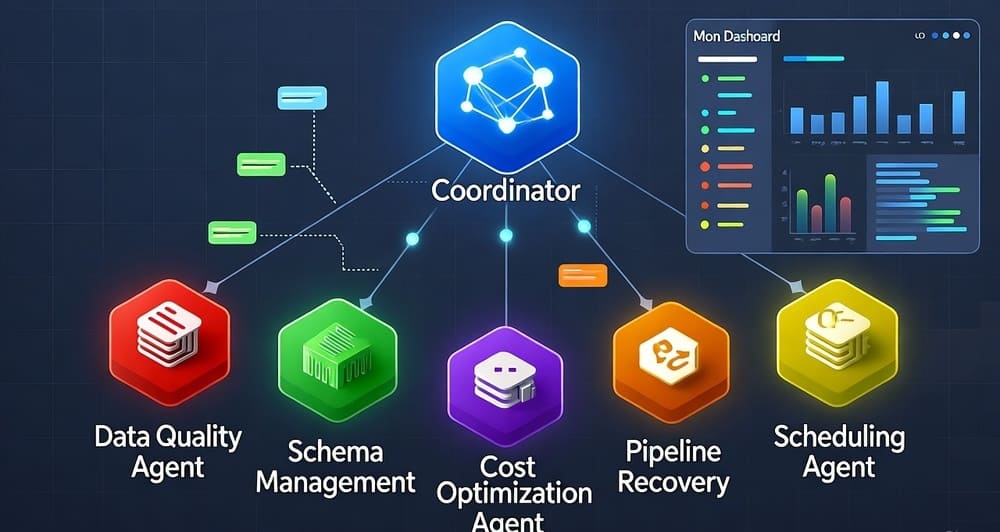Parquet: The Columnar Storage Format Powering Modern Data Architecture
In the world of big data and analytics, the way you store your data can be just as important as the data itself. Enter Apache Parquet—a columnar storage file format that has revolutionized how organizations store, process, and analyze massive datasets. If you’re working with data at scale, understanding Parquet isn’t just useful—it’s essential.
Beyond Traditional Storage Formats
Traditional row-based formats like CSV, JSON, or even Avro store data in a record-by-record fashion. While intuitive for many applications, these formats become increasingly inefficient as data volumes grow and analytical workloads become more complex.
Parquet took a different approach by organizing data by columns rather than rows, unleashing a cascade of performance improvements that have made it a cornerstone of modern data architecture.
The Columnar Advantage
At its core, Parquet’s columnar design offers several fundamental advantages:
1. I/O Efficiency for Analytical Queries
Most analytical queries access only a subset of columns:
sql-- This query only needs access to 2 columns
SELECT avg(revenue)
FROM sales
WHERE date >= '2023-01-01'
In row-based formats, the system must read entire rows even if you need just a few fields. With Parquet’s columnar approach, it reads only the needed columns, often reducing I/O by 90% or more.
2. Improved Compression
When data is organized by column, similar values are stored together, dramatically improving compression ratios:
Row format: ["John", 35, "New York"] ["Maria", 42, "Chicago"] ["John", 28, "Boston"]
Column format: ["John", "Maria", "John"] [35, 42, 28] ["New York", "Chicago", "Boston"]In the column format, the repetition of “John” enables better compression. Across large datasets, this pattern leads to significantly smaller files—often 75% smaller than equivalent CSV files.
3. Efficient Encoding Schemes
Parquet applies type-specific encoding to each column:
- Dictionary encoding for columns with repeated values
- Run-length encoding for sequences of identical values
- Bit-packing for integer values with limited ranges
These encoding schemes further reduce size while maintaining query performance.
Anatomy of a Parquet File
A Parquet file consists of:
Header
Contains the magic number “PAR1” identifying it as a Parquet file
Data Blocks (Row Groups)
The file is divided into row groups (typically 128MB each), which contain:
- Column chunks for each column
- Column metadata including statistics (min/max values, null count)
Footer
Includes:
- File metadata
- Schema information
- Row group metadata
- The offset to access each column chunk
┌───────────────── Parquet File ─────────────────┐
│ │
│ ┌─────────┐ │
│ │ Header │ "PAR1" │
│ └─────────┘ │
│ │
│ ┌─────────────── Row Group 1 ─────────────────┐│
│ │ ││
│ │ ┌────────────┐ ┌────────────┐ ┌────────────┐││
│ │ │ Column 1 │ │ Column 2 │ │ Column 3 │││
│ │ │ Chunk │ │ Chunk │ │ Chunk │││
│ │ └────────────┘ └────────────┘ └────────────┘││
│ └─────────────────────────────────────────────┘│
│ │
│ ┌─────────────── Row Group 2 ─────────────────┐│
│ │ ... ││
│ └─────────────────────────────────────────────┘│
│ │
│ ┌─────────┐ │
│ │ Footer │ File Metadata, Schema, etc. │
│ └─────────┘ │
│ │
│ ┌─────────┐ │
│ │ Footer │ Length of footer (4 bytes) │
│ │ Length │ │
│ └─────────┘ │
│ │
│ ┌─────────┐ │
│ │ Footer │ "PAR1" │
│ └─────────┘ │
└────────────────────────────────────────────────┘This structure enables several powerful capabilities:
Predicate Pushdown
Column statistics allow Parquet readers to skip entire blocks that can’t match query filters:
python# In this query, Parquet can use min/max statistics
# to skip blocks where date < '2023-01-01'
df = spark.read.parquet("s3://data/sales/")
filtered = df.filter(df.date >= "2023-01-01")
Projection Pushdown
Parquet’s columnar structure allows readers to load only the required columns:
python# Only the 'date' and 'revenue' columns will be read from disk
df = spark.read.parquet("s3://data/sales/")
result = df.select("date", "revenue")
Parquet in the Modern Data Stack
Integration with Compute Engines
Parquet works seamlessly with nearly every modern data processing tool:
Apache Spark
python# Reading Parquet with Spark
df = spark.read.parquet("path/to/data")
# Writing Parquet with Spark
df.write.parquet("output/path",
compression="snappy",
partitionBy="date")
Python Pandas
pythonimport pandas as pd
import pyarrow as pa
import pyarrow.parquet as pq
# Read Parquet file
df = pd.read_parquet("data.parquet")
# Write Parquet file with PyArrow for better performance
table = pa.Table.from_pandas(df)
pq.write_table(table, "output.parquet", compression="snappy")
SQL Engines (Presto/Trino, BigQuery, Snowflake)
sql-- Querying Parquet directly in Presto/Trino
SELECT
date_trunc('month', order_date) as month,
customer_region,
SUM(order_total) as revenue
FROM orders
WHERE order_date >= DATE '2023-01-01'
GROUP BY 1, 2
ORDER BY 1, 3 DESC
Cloud Data Lakes
Parquet has become the default storage format for cloud data lakes:
- AWS: S3-based data lakes with Athena, EMR, and Redshift Spectrum
- Azure: Azure Data Lake Storage with Synapse Analytics
- Google Cloud: Cloud Storage with BigQuery and Dataproc
Streaming to Batch Integration
Modern architectures often use Parquet as the persistent storage layer for processed streaming data:
┌────────────┐ ┌────────────┐ ┌────────────┐
│ │ │ │ │ │
│ Kafka/ │──────▶ Streaming │──────▶ Parquet │
│ Kinesis │ │ Process │ │ Files │
│ │ │ │ │ │
└────────────┘ └────────────┘ └────────────┘
│
▼
┌────────────┐
│ │
│ Batch │
│ Analysis │
│ │
└────────────┘Technical Deep Dive
Data Types and Encoding
Parquet supports a rich set of data types:
- Primitive types: boolean, int32, int64, int96, float, double, byte_array, fixed_len_byte_array
- Logical types: string, uuid, decimal, date, time, timestamp, list, map, etc.
Each type is stored with appropriate encoding:
Column type: String with repeated values
Storage: Dictionary encoding
Example: ["USA", "Canada", "USA", "Mexico", "Canada", "USA"]
Encoded as: Dictionary: [0: "USA", 1: "Canada", 2: "Mexico"]
Values: [0, 1, 0, 2, 1, 0]
Column type: Integer sequence
Storage: Run-length encoding
Example: [5, 5, 5, 5, 5, 6, 6, 6, 8, 8, 8, 8]
Encoded as: [(value: 5, count: 5), (value: 6, count: 3), (value: 8, count: 4)]Schema Evolution
Parquet supports schema evolution, allowing you to:
- Add new columns
- Remove columns
- Rename columns (with some limitations)
- Change column types (if the types are compatible)
This schema evolution capability is crucial for real-world applications where data models inevitably change over time.
Nested Data Structures
Parquet efficiently handles complex nested data structures:
python# Example of nested data in Python
data = [
{
"customer_id": 1,
"name": "John Smith",
"orders": [
{"order_id": 101, "items": ["book", "pen"]},
{"order_id": 102, "items": ["laptop"]}
]
},
{
"customer_id": 2,
"name": "Jane Doe",
"orders": [
{"order_id": 103, "items": ["phone", "headphones"]}
]
}
]
# This nested structure is preserved in Parquet
df = pd.DataFrame(data)
df.to_parquet("nested_data.parquet")
Parquet uses a technique called “shredding” to represent nested structures efficiently in a columnar format.
Optimization Techniques
Partitioning
Parquet works exceptionally well with partitioned datasets:
s3://data-lake/sales/
├── year=2021/
│ ├── month=01/
│ │ ├── part-00000.parquet
│ │ └── part-00001.parquet
│ └── month=02/
│ ├── part-00000.parquet
│ └── part-00001.parquet
└── year=2022/
└── ...Partitioning allows for skipping entire directories based on filter conditions:
python# This query will only read files in year=2022/month=03/
df = spark.read.parquet("s3://data-lake/sales/")
march_2022 = df.filter((df.year == 2022) & (df.month == 3))
Compression Options
Parquet supports multiple compression algorithms:
- Snappy: Fast compression/decompression with moderate compression ratio
- Gzip: Higher compression ratio but slower
- Zstandard: Excellent balance of compression and speed
- LZ4: Very fast with reasonable compression
- Uncompressed: For already compressed data or maximum read speed
For most use cases, Snappy or Zstandard provide the best balance of performance and file size.
Tuning Row Groups and Page Sizes
Fine-tuning these parameters can significantly impact performance:
python# PyArrow example with custom row group and page size
pq.write_table(
table,
"optimized.parquet",
compression="zstd",
row_group_size=1048576, # 1M rows per row group
data_page_size=131072 # 128K data pages
)
- Row group size: Larger row groups improve compression but require more memory
- Page size: Smaller pages allow more granular reading but increase overhead
Statistics and Indexes
Parquet automatically collects statistics for each column:
- Min/max values
- Null count
- Distinct count (optional)
Column: order_date
Statistics: min=2023-01-01, max=2023-03-31, null_count=0
Column: customer_id
Statistics: min=1000, max=9999, null_count=42These statistics enable efficient predicate pushdown, allowing readers to skip irrelevant data blocks.
Performance Benchmarks
The benefits of Parquet are measurable and significant:
Storage Efficiency
For a typical analytics dataset:
- CSV: 1 TB
- JSON: 1.5 TB
- Avro: 750 GB
- Parquet: 380 GB
Query Performance
For a filtering and aggregation query:
- CSV: 45 seconds
- JSON: 65 seconds
- Avro: 30 seconds
- Parquet: 8 seconds
These improvements scale with data size—the larger your dataset, the more dramatic the benefits.
Real-World Use Cases
Data Warehousing
Parquet serves as an excellent storage format for data warehousing:
┌────────────┐ ┌────────────┐ ┌────────────┐
│ │ │ │ │ │
│ Source │──────▶ ETL │──────▶ Parquet │
│ Systems │ │ Process │ │ Data Lake │
│ │ │ │ │ │
└────────────┘ └────────────┘ └────────────┘
│
▼
┌────────────┐
│ │
│ SQL Query │
│ Engine │
│ │
└────────────┘Organizations typically see:
- 40-80% reduction in storage costs
- 60-95% improvement in query performance
- Significant reduction in compute resources needed
Machine Learning Pipelines
ML workflows benefit from Parquet’s efficient data loading:
python# ML pipeline with Parquet
import pandas as pd
from sklearn.model_selection import train_test_split
from sklearn.ensemble import RandomForestClassifier
# Fast loading of training data
df = pd.read_parquet("training_data.parquet")
# Select only needed features
features = df[['feature1', 'feature2', 'feature3']]
target = df['target']
# Train model
X_train, X_test, y_train, y_test = train_test_split(features, target)
model = RandomForestClassifier()
model.fit(X_train, y_train)
Benefits include:
- Faster model training iterations
- Reduced memory footprint
- Efficient feature selection
Time-Series Analytics
Time-series data stored in Parquet typically sees:
- 5-20x faster range queries
- Efficient aggregation across time periods
- Better compression of sequential timestamps
Common Challenges and Solutions
Challenge: Small Files Problem
When working with Parquet, generating too many small files can degrade performance.
Solution: Implement file compaction processes
python# Spark file compaction example
small_files = spark.read.parquet("path/with/small/files/")
small_files.coalesce(10).write.parquet("optimized/output/path")
Challenge: Schema Evolution Complexity
Managing evolving schemas requires careful planning.
Solution: Use explicit schema definitions and compatibility checking
python# PyArrow schema definition
import pyarrow as pa
schema = pa.schema([
pa.field('id', pa.int64()),
pa.field('name', pa.string()),
pa.field('created_at', pa.timestamp('ms'))
])
# Read with schema validation
table = pq.read_table("data.parquet", schema=schema)
Challenge: Processing Highly Nested Data
Deeply nested structures can be challenging to query efficiently.
Solution: Consider flattening highly nested structures or use engines optimized for nested data (like Spark)
Best Practices
1. Partitioning Strategy
Choose partition keys wisely:
- Partition on frequently filtered columns
- Avoid over-partitioning (aim for partition files >100MB)
- Consider multi-level partitioning for very large datasets
python# Effective partitioning in Spark
df.write.parquet("s3://data/events/",
partitionBy=["year", "month", "day"])
2. Compression Selection
Match compression to your workload:
- Snappy: Balanced performance (default in many systems)
- Zstandard: Best option for most modern workloads
- Gzip: When storage cost is the primary concern
- Uncompressed: For data that’s already compressed (images, etc.)
3. File Size Optimization
Aim for optimal file sizes:
- Target 128MB-1GB per file
- Implement compaction for small files
- Use appropriate row group sizes (default: 128MB)
4. Schema Design
Design schemas with analytics in mind:
- Use appropriate data types (e.g., int32 vs int64)
- Consider column order (frequently accessed columns first)
- Plan for schema evolution
5. Reading Strategy
Implement efficient reading patterns:
- Select only needed columns
- Push predicates down to leverage statistics
- Use parallel reading when possible
python# Efficient Parquet reading with PyArrow
import pyarrow.parquet as pq
# Only read specific columns
table = pq.read_table("large_dataset.parquet",
columns=['date', 'customer_id', 'amount'])
# Convert to pandas if needed
df = table.to_pandas()
The Future of Parquet
Parquet continues to evolve with several exciting developments:
Enhanced Encryption
Column-level encryption capabilities are being developed to address sensitive data concerns while maintaining analytics capabilities.
Cloud-Native Optimizations
Improvements for cloud object stores include:
- Enhanced metadata caching
- Optimized for object store read patterns
- Better handling of eventual consistency
Integration with Modern Formats
The Parquet community is working on better integration with emerging formats:
- Delta Lake
- Apache Iceberg
- Apache Hudi
┌───────────────────────┐
│ │
│ Table Formats │
│ (Delta, Iceberg, │
│ Hudi) │
│ │
└───────────┬───────────┘
│
▼
┌───────────────────────┐
│ │
│ Storage Format │
│ (Parquet) │
│ │
└───────────────────────┘Conclusion
Apache Parquet has established itself as a cornerstone of modern data architecture by addressing the fundamental challenges of big data storage and processing. Its columnar structure, efficient compression, and integration with the broader data ecosystem make it an essential technology for any organization dealing with large-scale data analytics.
The performance benefits aren’t just incremental—they’re transformative. Organizations regularly report order-of-magnitude improvements in query performance and storage efficiency after adopting Parquet, directly translating to reduced costs and faster insights.
As data volumes continue to grow and analytics workloads become more demanding, Parquet’s importance will only increase. Whether you’re building a data lake, optimizing a machine learning pipeline, or simply trying to make your analytical queries run faster, Parquet offers a proven solution that scales with your needs.
By understanding and implementing the best practices outlined in this article, you can leverage the full power of Parquet to build more efficient, performant, and cost-effective data systems.
Hashtags: #ApacheParquet #ColumnarStorage #DataEngineering #BigData #DataLake #Analytics #Spark #DataOptimization #CloudStorage #DataProcessing





